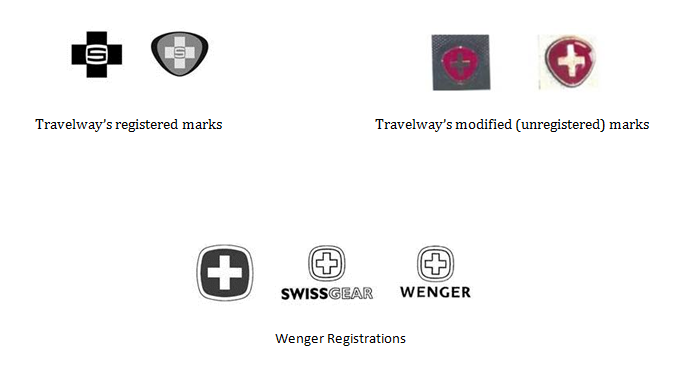
Can a Registered Mark Infringe Another Registered Mark and Remain Valid? – The Swiss Cross Trademark Saga Continues

The Federal Court of Appeal in Group III International Ltd. v. Travelway Group International Ltd., 2017 FCA 215 overturned the lower court decision (2016 FC 347), and granted Wenger S.A. a permanent injunction prohibiting Travelway from using its own registered trademarks on its luggage products; a Declaration of infringement; and an order that Travelway deliver up its luggage products for destruction. Notably, however, the Federal Court of Appeal did not expunge Travelway’s trademark registrations or issue an order for damages, referring these matters back to the lower court to allow for further submissions. The decision of the Federal Court of Appeal has now resulted in a perplexing outcome: trademark registrations found to be confusing nevertheless continue to co-exist on the Trademarks Register.
The Plaintiff, Wenger, was a Swiss company that owned several trademark registrations for luggage products that featured a cross design inside a border. The marks registered between 2007 and 2012, although, through a licensee and distributor, Wenger’s luggage had been sold in Canada featuring these marks since 2003. In 2008, the Defendant, Travelway, partnered with a Swiss company to design a line of luggage and, in 2009, obtained registrations for two trademarks featuring the letter “S” inside a cross design. Neither of the Travelway applications was opposed by Wenger. By 2012, however, Travelway modified its cross design marks and, in particular, minimized the appearance of the letter “S” or eliminated it entirely. Travelway’s use of the modified cross logos prompted Wenger’s application seeking, inter alia, a declaration of infringement and passing off, as well as expungement of Travelway's registrations.
The parties’ respective marks are depicted below:
The Federal Court initially dismissed Wenger’s application in its entirety. On the issue of confusion, the Court gave separate consideration to Travelway’s trademark registrations and its unregistered modified logos, featuring the “disappearing” letter S design. The Court found that Travelway’s trademark registrations did not so closely resemble the Wenger registrations as to cause a likelihood of confusion. With respect to Travelway’s modified unregistered marks, the Court noted that they bore a greater resemblance to the Wenger registrations, but found that the Wenger registrations were not distinctive in light of third party uses of similar cross designs, and that consumers were not likely to recognize the Wenger cross logos as designating a single source. The Court also found that since Travelway’s modified logos were used only on the zipper pulls of its luggage, and since the zipper pulls were so small, it was unlikely that the average consumer, somewhat in a hurry, would even notice this use and could not be confused. Wenger’s survey evidence was also found to be unnecessary and given no weight.
The Federal Court of Appeal held that the lower court’s distinction between Travelway’s registered and unregistered marks was unreasonable and incorrect, finding instead that the modified versions of the marks used by Travelway retained the dominant features of the registered marks and hence, should not have been treated as separate from the Travelway registrations. In coming to this conclusion, however, the Court relied on case law dealing with the extent to which use of a variation of a registered mark would constitute use of the registration, in the context of non-use cancellation proceedings. Relying on this line of jurisprudence to assess whether use of a modified version of a registered mark would be considered use of the registration in the context of infringement proceedings between registered marks appears to have been a rather novel application of the earlier jurisprudence.
Also of note is that Wenger did not oppose registration of the Travelway registrations, nor did it commence litigation until Travelway modified its logos to look more similar to the Wenger registrations – nearly four years after the Travelway registrations issued. This suggests that Wenger itself may not have considered Travelway’s registered marks to be “confusing” with its own registrations.
Nevertheless, the Federal Court of Appeal assessed the issue of confusion based on a comparison of the Travelway registrations (which included the modified uses), and the Wenger registrations. Noting that the lower court’s failure to review the relevant criteria for assessing confusion other than the “degree of resemblance” between the marks was “a palpable and overriding error”, the Federal Court of Appeal found that the marks bore a “very strong resemblance” to each other and, after considering “all of the circumstances”, it concluded that other factors—such as the length of time each mark was in use, and their inherent distinctiveness—favoured a finding of confusion. The Court also disagreed that the existence of third party “Swiss Cross” marks would have negatively impacted the distinctiveness of the Wenger registrations, noting “this factor does not completely erode the acquired distinctiveness of the Wenger cross mark that it has gained through years of strong sales”.
A similar holding resulted for Wenger’s passing off claim, overturning the lower court’s finding that Wenger could not establish goodwill in its marks due to the existence of other third party trademarks with similar Swiss-cross features. To round out the second and third elements of passing off (not considered by the lower court) the Federal Court of Appeal held that Travelway’s use of confusing marks was a misrepresentation, and that there was likely damage caused by this confusion since the parties are direct competitors for luggage and bags in Canada, and sell through effectively the same retail outlets.
This result is important because it strongly suggests that a valid trademark registration may not be a complete defence to claims of infringement and passing off, departing from earlier case law. Prior to Travelway, a party claiming against a trademark registration needed the court to invalidate the registration and expunge it from the Register before their action against that mark could succeed. This is because trademark registrations are presumed valid and grant to their owner the exclusive right to use such mark throughout Canada. However, in Travelway, the Federal Court of Appeal found that the defendant’s registered trademarks infringed and passed off on the plaintiff’s registered trademarks, but did not order the expungement of the defendant’s registrations, referring the issue of expungement back to the lower court. Given the Federal Court of Appeal’s finding on infringement, it is likely that the lower court will have no option but to expunge the Travelway registrations. However, the decision, as it stands now, creates uncertainty for trademark owners who seek to rely on their trademark registration as a shield against infringement, passing off, and other such claims. It also leaves open the question of whether such trademark registrations could be relied on to take action against other parties. Further, leaving confusing marks on the Register will add considerable uncertainty to trademark clearance searches.




